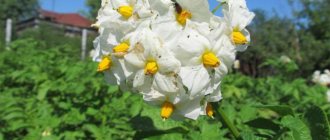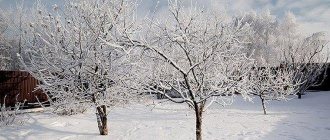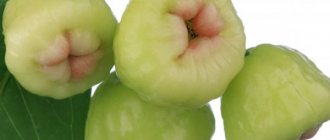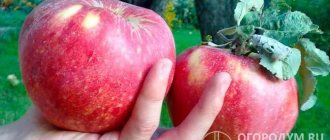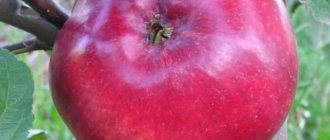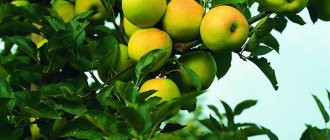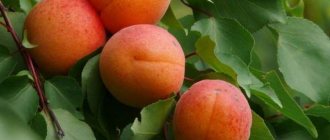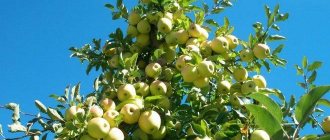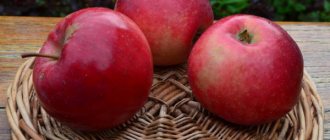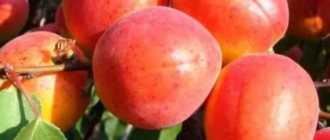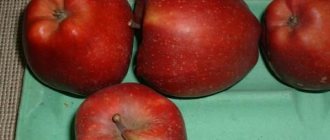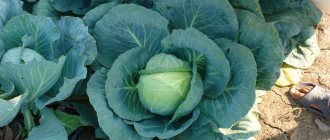Apple trees are a full member of almost every garden. They bear fruit abundantly from mid-summer until late autumn. More and more new varieties and hybrids with high technical characteristics are being created. But there are also classic varieties that have been popular for decades. One of these is the Gloucester apple tree, one of the most famous apple trees in Europe.
Gloucester apple variety.
Main characteristics
Gloucester is a variety with high characteristics. Its parents were the no less famous varieties Richard Delicious and Glockenapfrel, from which the consumer qualities of the fruit and sustainability were taken.
Advantages and disadvantages
It is the advantages of the variety that make it so popular:
- taste and technical characteristics of fruits;
- bountiful harvest;
- good immunity to fungi.
The disadvantage is the high growth rate, which requires special attention.
Annual growth
The young Gloucester apple tree grows very quickly. But the shoots are small and there are few of them, but the location is chaotic. Mature trees also produce quite large growth, up to 10 cm per year.
Precociousness
The apple tree is quite early-bearing; the first fruits are harvested from it in the 4th year. When growing Gloucester on a dwarf rootstock, the first fruits are harvested even earlier, already in the 2nd year.
Tasting assessment
Apples are round, regular in shape, one-dimensional. The pulp is dense, sweet and sour, even more sweet. According to the tasting scale, experts gave the variety a high mark, about 4.6-4.7 points.
The photo shows ripe fruits of the Gloucester variety.
Chemical composition of fruits
Gloucester fruit contains a large amount of antioxidants. They contain useful minerals - zinc, iron and sodium. But the content of ascorbic acid in fruits is small.
Productivity
Under proper care conditions, subject to all principles of agricultural technology, the harvest amount is about 75 kg. But if proper agricultural practices are violated or diseases occur, the number of fruits decreases.
Winter hardiness
The high resistance to cold of the Gloster variety is one of its tangible advantages. Even with prolonged cold weather of about -35 degrees, the apple tree does not freeze; even thin fruit twigs are not damaged.
Disease resistance
Gloucester is not afraid of common diseases and easily resists scab and powdery mildew. Usually, simple preventive measures are enough to prevent the apple tree from getting sick.
Scab on an apple tree.
Growing areas
The resistant variety Gloucester gets along quite easily in almost any region. The entire territory of Russia is suitable for fruiting.
In colder regions, in the Urals or the North, planting the Gloster variety is also possible. But here it will be necessary to provide proper care and additional protection.
Appearance
The apples ripen to the same size and weigh about 200 grams. The shape of the fruit is round with ribs at the top. The pulp is juicy, tender, cream-colored. The color of the skin is raspberry-burgundy. On the tasting scale, the variety has 4.5 points.
In addition to their excellent external and taste properties, apples are a source of various nutrients: pectin, antioxidants, vitamins, micro- and macroelements, organic, unsaturated and saturated fatty acids.
A video about the large apple tree will complement your knowledge of the apple tree:
Features of planting and care
Correct landing will be the key to normal development. Experts advise buying a seedling that has reached the age of two years. It is he who takes root easier and faster.
For normal development, you need to choose the right landing site. It should be sunny and protected from gusts of wind as much as possible.
Landing dates
An apple tree can be planted equally successfully in spring or autumn. She is settling in well and growing. In spring, the procedure is carried out at the end of April, and in autumn - at the end of October.
A hole for planting an apple tree.
Distance
A medium-sized apple tree has a fairly wide and spreading crown. Therefore, you need to take into account the distance to the neighboring planting, up to 5 meters, so that all shoots have enough sunlight.
Scheme
Planting is very simple, using standard technology:
- The roots must be carefully checked, damaged ones removed and moistened with water.
- Organic matter and mineral fertilizers must be added to a pre-prepared hole.
- Place the seedling on the hill and straighten the roots.
- Place a small peg nearby for support.
- Sprinkle with soil and water well.
The unpretentious variety has one important feature. Gloster does not like deepening of the root neck at all; it should be above the ground level.
Growing
An important feature of care is proper watering. The variety does not tolerate drought at all and loves a sufficient amount of moisture. Therefore, you need to water it three times a month.
The process of watering an apple tree.
Another important condition for growing is shelter. To prevent freezing, it is important to cover the crown and mulch the tree trunk circle.
Agricultural technology
Caring for trees after planting consists of monitoring the condition of the seedling and watering it. From the second year it will be necessary to apply fertilizing.
Pruning and crown formation
After planting the next year, you need to trim the central conductor to stimulate the appearance of side shoots.
In the second year, you need to form a crown, cut off the branches so that the crown is sparsely tiered. Gloucester tolerates shaping well. But you need to be careful not to cut off more than 30% of the total number of branches so that the apple tree does not get sick.
Sanitary pruning can be combined with the shaping process. It is necessary to remove damaged shoots, frozen or broken. You also need to remove those that thicken the crown or grow inward. If large stumps leave wounds on the apple tree, they must be covered with garden varnish.
Detailed cropping diagram in the video.
Pollinator varieties
The Gloucester variety is self-fertile, and ovaries appear even without planting other crops nearby. But when planting pollinators, the yield will increase significantly. They are Idared, Gala, Spartan or Jonathan.
Video
We invite you to watch videos about the large-sized Gloucester, an apple tree on M 26 rootstock, and the first flowering of a two-year-old seedling in the garden:
Mom, wife and housewife, lawyer and accountant rolled into one. He never rests on his laurels and strives to gain new knowledge in a variety of areas. He is happy to share his discoveries in the field of gardening with readers.
Found a mistake? Select the text with the mouse and click:
“Frost-resistant” varieties of garden strawberries (more often simply “strawberries”) need shelter just as much as ordinary varieties (especially in those regions where there are snowless winters or frosts alternating with thaws). All strawberries have superficial roots. This means that without shelter they freeze to death. Sellers’ assurances that strawberries are “frost-resistant,” “winter-hardy,” “tolerates frosts down to −35 ℃,” etc. are deception. Gardeners must remember that no one has yet managed to change the root system of strawberries.
One of the most convenient methods for preparing a harvest of vegetables, fruits and berries is freezing. Some believe that freezing causes the nutritional and health benefits of plant foods to be lost. As a result of the research, scientists have found that there is practically no decrease in nutritional value when frozen.
Oklahoma farmer Carl Burns developed an unusual variety of multi-colored corn called Rainbow Corn. The grains on each cob are of different colors and shades: brown, pink, purple, blue, green, etc. This result was achieved through many years of selecting the most colored ordinary varieties and crossing them.
In Australia, scientists have begun experiments in cloning several varieties of grapes grown in cold regions. Climate warming, which is predicted for the next 50 years, will lead to their disappearance. Australian varieties have excellent characteristics for winemaking and are not susceptible to diseases common in Europe and America.
You need to collect medicinal flowers and inflorescences at the very beginning of the flowering period, when the content of nutrients in them is highest. Flowers are supposed to be picked by hand, tearing off the rough stalks. Dry the collected flowers and herbs, scattered in a thin layer, in a cool room at natural temperature without access to direct sunlight.
Humus is rotted manure or bird droppings. It is prepared like this: the manure is piled up in a heap or pile, layered with sawdust, peat and garden soil. The pile is covered with film to stabilize temperature and humidity (this is necessary to increase the activity of microorganisms). The fertilizer “ripens” within 2-5 years, depending on external conditions and the composition of the feedstock. The output is a loose, homogeneous mass with a pleasant smell of fresh earth.
It is believed that some vegetables and fruits (cucumbers, stem celery, all varieties of cabbage, peppers, apples) have “negative calorie content,” that is, more calories are consumed during digestion than they contain. In fact, only 10-20% of the calories received from food are consumed in the digestive process.
Compost is rotted organic remains of various origins. How to do it? They put everything in a heap, hole or large box: kitchen scraps, tops of garden crops, weeds cut before flowering, thin twigs. All this is layered with phosphate rock, sometimes straw, earth or peat. (Some summer residents add special composting accelerators.) Cover with film. During the process of overheating, the pile is periodically turned or pierced to bring in fresh air. Typically, compost “ripens” for 2 years, but with modern additives it can be ready in one summer season.
From varietal tomatoes you can get “your own” seeds for sowing next year (if you really like the variety). But it is useless to do this with hybrids: you will get seeds, but they will carry the hereditary material not of the plant from which they were taken, but of its numerous “ancestors”.
Ripening and fruiting
Taking into account the characteristics of fruiting and harvesting, you can get a bountiful harvest and preserve it for as long as possible.
Beginning of fruiting
The first harvest can be obtained within 3-4 years after planting the fruit crop. But there won't be that much fruit. A fast-growing apple tree quickly increases its harvest.
Peculiarities
The prevalence of the variety provides its positive features. Fruits set regularly without cyclicity. Fruits last a long time and are stored, not prone to shedding.
Fruit ripening time
The late-autumn variety often even belongs to the winter variety, the ripening dates are corresponding. Gloucester fruit is usually picked at the end of September or even at the beginning of October.
Ripe apple fruits.
Harvest and storage
An amazing feature is that apples only become tastier during storage. At low temperatures and high humidity, fruits can be eaten until May.
Disadvantages of a fruit tree
The Gloucester variety has a large number of good qualities.
- The advantages of the variety include the excellent taste and beauty of apples.
- The fruits can be eaten fresh or used to prepare a variety of dishes and preparations.
- Antioxidants have a positive effect on cardiac activity and normalize blood pressure.
- Vitamin C, pectin and magnesium salts increase immunity and protect against atherosclerosis.
- Apples help remove excess cholesterol from the blood.
- Pectin contained in fruits removes cholesterol from the liver. Also, they normalize metabolism and help lose weight, remove toxins and harmful substances.
- For gastritis and stomach ulcers, apples can be consumed only in small quantities; an excess of fruit can aggravate the course of the disease.
- The apple tree is winter-hardy and can withstand frosts down to -25 degrees.
- The variety has very high resistance to powdery mildew, and average resistance to scab.
- The fruits are stored for a long time and are easy to transport.
The disadvantage of this variety is the freezing of buds and shoots during spring frosts.
- Great taste and beautiful appearance of apples.
- I use the harvest to make jam, preserves, purees, and also eat it fresh with the whole family in winter.
- Apples can be called rejuvenating. Iron increases hemoglobin, antioxidants fight harmful radicals, trace elements and vitamins increase the body's immune defense and prevent atherosclerosis.
- Pectin improves metabolism, like a broom removes toxins and cholesterol from the body.
- The fruit tree is easy to grow. Tolerates severe cold up to 25 degrees below zero.
- Innate immunity protects the tree from infection by powdery mildew, and to some extent from scab.
- The long shelf life of apples makes them an indispensable source of vitamins in the spring during the period of vitamin deficiency.
To form ovaries on an apple tree, it is necessary to plant a number of varieties that coincide in flowering time.
Young shoots and swollen buds are afraid of sub-zero temperatures and may suffer when spring frosts occur.
Subspecies and options
Gloucester itself became the material for grafting and creating other varieties. It can also be grafted easily.
On a dwarf rootstock
The dwarf culture Gloucester has an advantage precisely in the size of the crown. It becomes more compact, the height of the apple tree usually reaches 3 meters. Fruiting begins earlier, and the variety becomes resistant to return frosts. Dwarf varieties need to be supported.
Columnar
The Gloucester apple tree is also grown as a columnar apple tree. It has a lot of advantages: the apple tree is short, productive and easy to use. But there is also an important drawback: the speaker requires more careful care, and its lifespan is noticeably shorter.
Apple tree on a columnar rootstock.
What variations of the Gloucester variety are there?
This variety is the starting material for obtaining new varieties of apple trees. In addition, it is often grafted onto other varieties. Gloucester, which has a dwarf rootstock, has a number of advantages. This apple tree grows quite compact in size, about two to two and a half meters in height, the crown is three meters wide. Such trees begin to bear fruit faster; they have good resistance to low temperatures in the spring. Since the plants are compact, they are easier to care for. It is worth remembering that in dwarf apple trees, the rhizomes are usually located in the top layer of the soil. Therefore, it is necessary to water periodically, and also not to forget about additional insulation for the winter.
For a more stable location of the plant, it is necessary to drive a peg.
This variety may have a columnar rootstock. This tree is semi-dwarf in size. It grows in height by a maximum of two meters. The crown grows quite densely, which saves space in the garden. Such apple trees take root very well and quickly; Gloucester begins to bear fruit in the second year after it was planted. The yield results can also be quite good; such trees have a decorative appearance. Among the disadvantages, it can be noted that such an apple tree bears fruit for a short time. After about fifteen years of trees, it makes sense to replace the old trees with new ones. It is imperative to protect trees from attacks by rodents.
Growing in different regions
Although cultivation throughout Russia is possible, there are a number of nuances that should be taken into account when planting.
In outskirts of Moscow
Growing in the Moscow region and its environs will not be difficult. But in hot, dry summers, additional watering will be required. During the period of spring frosts, fruit buds retain their properties.
In Siberia
Not every variety of apple tree can withstand the cold Siberian winters. Gloucester can only be grown with additional insulation. It is necessary to mulch and cover the tree trunk circle, and also, if possible, wrap the crown.
In the Urals
It is possible to grow an apple tree in the Urals, but with caution. Here you will need to take care of the support and carry out systematic feeding. An important condition should be timely whitewashing of the trunk, because the delicate bark suffers from frost damage.
In Belarus
Apple trees have been successfully grown in Belarus for many years. But it will be necessary to carry out preventive spraying against scab, because it is in this region that the risk of its occurrence is maximum.
In Ukraine
The climatic features of Ukraine are excellent for growing Gloucester. But often sandy soil does not have enough useful substances and regular fertilization will be required.
Reviews
Veronica. Sevsk. “Even though I do gardening myself, I still buy apples at the store in winter. I really like Gloucester apples. They have an attractive appearance and very sweet, juicy pulp . You can find them in almost all markets and stores. I would like to add that they can be stored for a long time without any processing and are harmless when consumed.”
Dolgikh. S. Astrakhan region. “For a long time I have been growing only one variety of apple trees, Gloucester. I have about 12 trees growing . I settled on this variety only because the apples are very transportable and in demand; I bought them after I studied the description of the photo. The trees are also easy to care for and do not take much time. I carry out only spring and autumn treatments. In summer, during droughts, I irrigate using the rain method.”
Mashkova S.V. Abinsk. “When I purchased a Gloucester apple tree several years ago, I did not even expect such a yield. From one tree I remove about 50 kilograms of fruit . Apples with a beautiful presentation have very tasty pulp. In the autumn, my housemates line up when I bring them home from the dacha. Sometimes there isn't even enough for everyone. I would like to add that the apple tree itself is developing well and does not cause any additional trouble.”
